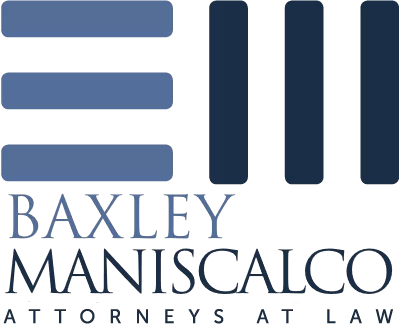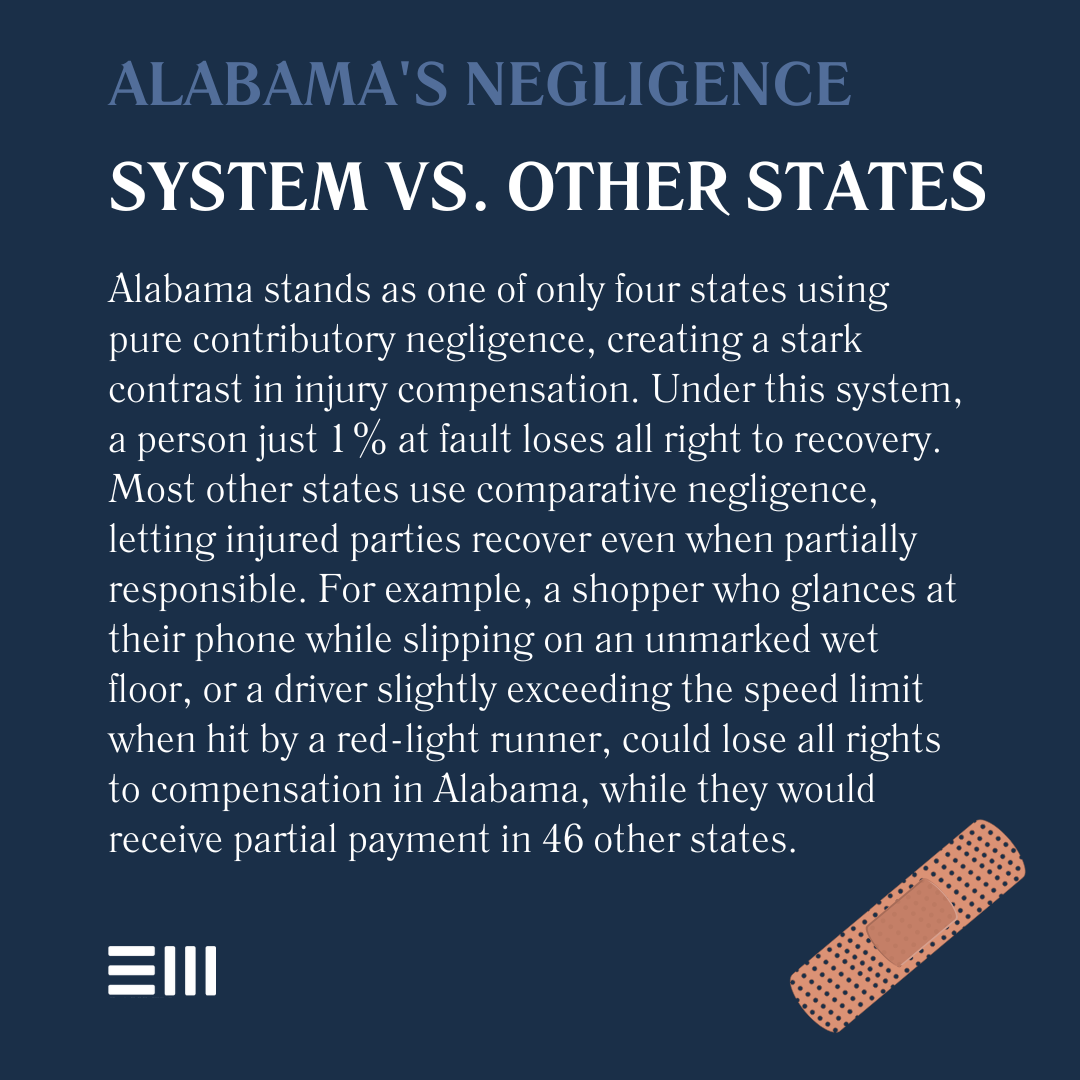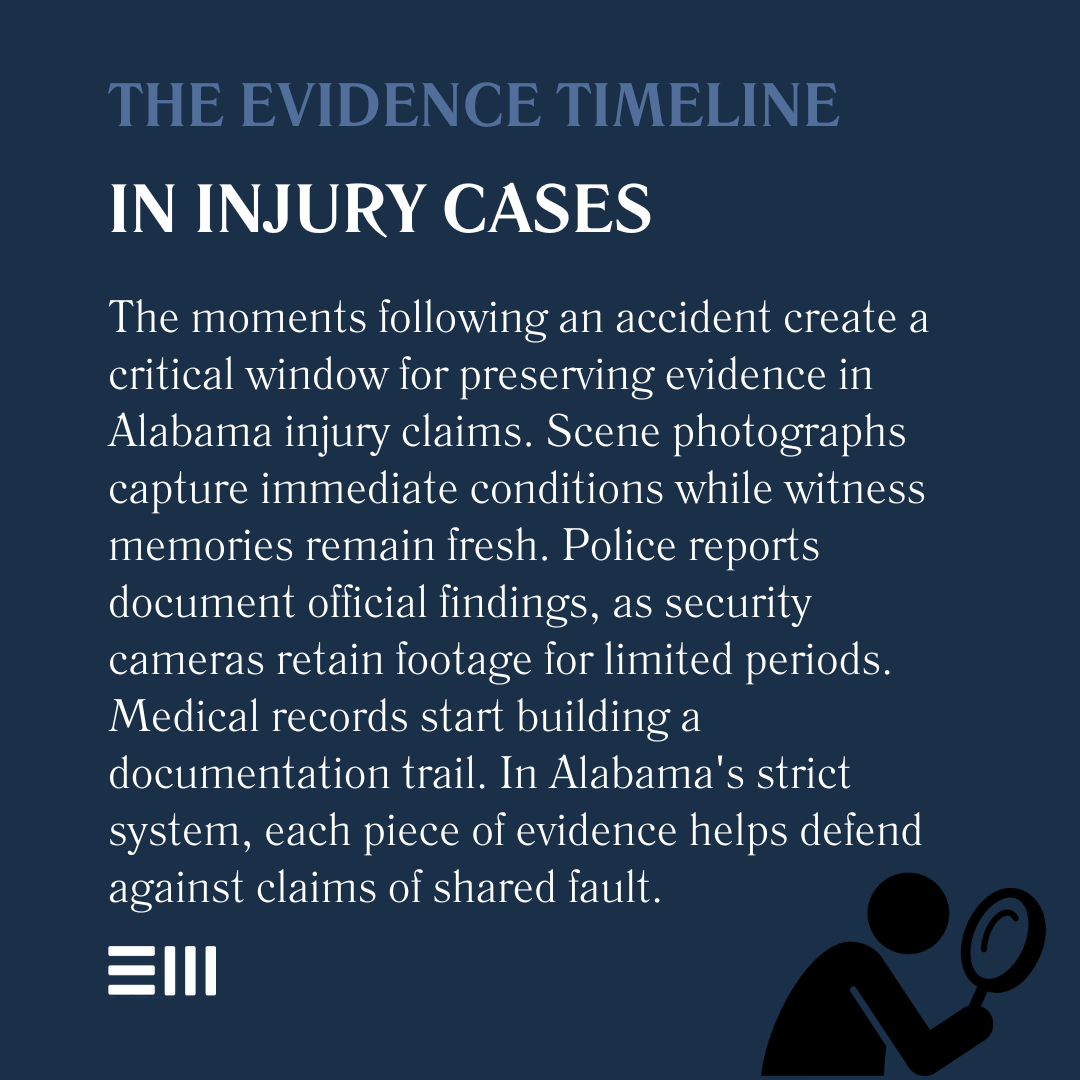In Alabama, a single moment of inattention can cost you everything.
Unlike 46 other states, Alabama remains one of only four states that can completely bar you from recovery if you're found even 1% at fault for an accident.
A pedestrian who steps slightly off the curb, a driver who changes lanes without perfect timing, or a shopper who glances at their phone while walking—all could lose their right to compensation entirely, even if the other party was 99% responsible for their injuries.
Alabama's Unique Contributory Negligence Standard
Alabama stands apart from most states with its strict contributory negligence rule, creating significant challenges for injury victims seeking compensation.
This distinctive legal framework shapes every aspect of personal injury claims in the state, from initial documentation to final settlement negotiations.
Understanding Contributory vs. Comparative Negligence
The difference between contributory and comparative negligence systems fundamentally affects how injury claims are handled and compensated across jurisdictions.
Each system reflects different approaches to fairness and responsibility in personal injury cases.
- Contributory Negligence: Alabama's system that bars recovery if plaintiff is even 1% at fault, representing the strictest approach to personal injury compensation in the United States.
- Pure Comparative: States where recovery reduces by exact percentage of fault, allowing plaintiffs to recover damages even if they bear significant responsibility.
- Modified Comparative: Systems allowing recovery if plaintiff's fault is below 50% or 51%, representing a middle ground between pure comparative and contributory negligence.
- Historical Context: Contributory negligence's origins in 19th-century English common law, maintained by Alabama despite nationwide trends toward comparative systems.
These varying approaches to negligence demonstrate how location can dramatically impact your ability to recover damages after an accident, with Alabama's system presenting unique challenges for injury victims.
Impact on Different Types of Claims
The contributory negligence rule affects various personal injury scenarios differently, requiring specific strategies for each type of case.
Understanding these distinctions helps injury victims prepare stronger claims.
- Car Accidents: Even minor traffic violations can bar recovery, such as being slightly over the speed limit or failing to signal a lane change.
- Premises Liability: Slight inattention can eliminate compensation rights, including cases where hazards were poorly marked or maintained.
- Workplace Injuries: Special considerations under workers' compensation, which operates under different rules than traditional personal injury claims.
- Product Liability: Impact of misuse on recovery potential, even when products have significant design flaws.
Understanding these impacts helps injury victims navigate their claims more effectively within Alabama's strict legal framework. Each type of case requires specific evidence and legal strategies.
Real-World Applications
Examining how Alabama's contributory negligence standard applies in actual situations helps illustrate its significant impact on injury claims.
- Shopping Center Incident: A customer slipping on an unmarked wet floor while briefly checking their phone could lose all right to recovery.
- Intersection Collision: A driver who had the right of way but was slightly exceeding the speed limit might be barred from compensation.
- Workplace Accident: An employee injured by faulty equipment might still have options under workers' compensation, even if partially at fault.
- Multi-Vehicle Crash: Complex scenarios where multiple parties share fault require careful analysis and documentation.
These examples demonstrate how Alabama's strict standard affects real people in everyday situations, highlighting the importance of thorough documentation and legal guidance.
Proving Fault and Maximizing Recovery
Given Alabama's strict standards, establishing clear evidence of the defendant's fault becomes paramount in personal injury cases. Success often depends on thorough preparation and strategic presentation of evidence.
Evidence Collection and Documentation
Thorough evidence gathering plays a crucial role in establishing fault and defending against contributory negligence claims. The moments and days following an incident are often critical for preserving essential evidence.
- Accident scene photographs capturing all relevant angles, lighting conditions, and contributing factors.
- Witness statements obtained promptly, including contact information and detailed accounts of observations.
- Police reports and official documentation, including any citations or measurements taken at the scene.
- Medical records documenting injuries, treatment plans, and professional medical opinions.
- Surveillance footage from nearby businesses or traffic cameras that might have captured the incident.
- Environmental conditions documentation, including weather reports and road conditions.
- Maintenance records for relevant equipment or facilities involved in the incident.
Proper documentation creates a strong foundation for demonstrating the defendant's primary responsibility for the accident, helping overcome potential contributory negligence defenses.
Strategies for Claim Success
Successfully navigating Alabama's contributory negligence system requires careful attention to specific legal strategies and considerations throughout the claims process.
- Immediate preservation of evidence through photographs, witness statements, and professional documentation.
- Early investigation conducted by experienced professionals who understand contributory negligence implications.
- Expert witness consultation and testimony to establish clear liability and causation.
- Careful communication with insurance companies to avoid admissions that might suggest contributory negligence.
- Understanding of relevant precedents and how they might apply to your specific case.
- Strategic timing of settlement negotiations based on evidence strength and case development.
- Preparation for potential trial presentation focusing on defendant's primary fault.
These approaches help maximize the chances of recovery under Alabama's strict liability standards, requiring careful attention to detail throughout the claims process.
Timeline Considerations
Understanding the critical timing elements in personal injury claims helps ensure proper handling and maximum potential recovery.
- Statute of limitations deadlines for filing claims in Alabama courts;
- Notice requirements for claims against government entities;
- Evidence preservation timeframes, especially for surveillance footage;
- Medical treatment documentation and follow-up schedules; and
- Insurance claim filing deadlines and response requirements.
Proper timing can significantly impact claim success, making early legal consultation particularly valuable in Alabama cases.
Common Questions About Comparative Negligence
Understanding Alabama's contributory negligence system raises numerous questions about rights, responsibilities, and potential outcomes in personal injury cases.
How Does Alabama's System Differ from Other States?
Alabama's contributory negligence system stands as one of the strictest in the nation, potentially barring recovery even with minimal fault. Most other states use comparative negligence, allowing partial recovery based on fault percentage.
What Evidence Helps Prove the Other Party's Fault?
Success in Alabama injury cases often depends on comprehensive evidence collection, including witness statements, expert testimony, surveillance footage, and thorough accident documentation.
When Should I Contact an Attorney After an Accident?
Given Alabama's strict standards, immediate legal consultation helps preserve crucial evidence and protect your rights. Early intervention often proves critical in building a strong case.
How Do Insurance Companies Use Contributory Negligence?
Insurance adjusters often investigate claims for any evidence of contributory negligence, knowing that even slight fault can bar recovery. Understanding this helps protect your interests during claim negotiations.
What if Multiple Parties Share Fault?
Multiple-party accidents present complex scenarios under Alabama law, requiring careful analysis of each party's role and potential liability.
Take Action to Protect Your Rights
Alabama's strict contributory negligence rules make experienced legal representation essential for protecting your right to compensation.
At Baxley Maniscalco, we understand how to navigate these complex laws and build the strongest possible case for our clients.
Contact us today for a free consultation about your injury claim.


